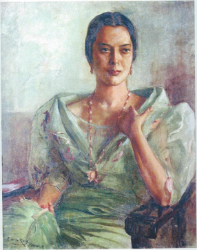The perception of narratives is sometimes deceiving. Where does the depiction of reality end? Where does the creation of fiction begin? We have been taught to see the world from the reflections of mediated objects: movies, newspapers, books, and paintings. Recently I find them exhibited at the galleries of the Lopez Museum for the Propagandaexhibit. Paintings by Filipino masters and national artists, installations by contemporary artists, heart-gripping multimedia art, and rare historical artifact compose a visually powerful and daunting walkthrough.
The exhibit is not a mere collection of objects significant to Filipino history. Although the walkthrough feels like a trip down memory lane -- concretized by objects belonging from the Hispanic period up to the present -- it performs much more than to reminisce.
Apart from commemorating the anniversary of the World War II (with respect to the presence of Japanese propaganda), it also anticipates the upcoming national elections. It performs the latter not simply because it exhibits politically-themed material. It makes us think of how we are supposed to read and interpret meaning-laden texts -- political campaign -- which carry narratives that are often fictitious or mythical.
Propaganda attempts to make the audience realize the power of the cultural object that fuels these events. In looking back, seeing the role of these texts in history, we acquire the opportunity to ponder how fictitious narratives shape and mold the Filipino consciousness.
Propaganda in Filipino history
Most people associate the term propaganda with the 19th century Philippines, specifically The Propaganda Movement. Rizal and other male elites used literature to raise social awareness and beg for political change. In fact, the use of propaganda in the country goes a long way before the 19th century. As early as the 17th century, friars have been using textbooks -- now restored at the Lopez Museum -- to propagate their own narratives regarding spirituality, religion, salvation, and Philippine society.
Our Filipino identity has been (and is) largely shaped by propaganda. The dissemination of ideas and the weaving of myths never ended in our history. In a span of a century, after the Hispanic rule (religion as propaganda), we endured the American rule (education as propaganda), the Japanese Occupation (movies and literature as propaganda), and the EDSA Revolution (mass media as propaganda). Up to the present, especially in the nearing of the 2016 elections, our consciousness is consistently molded by texts (campaign material as propaganda).
Where else do we find propaganda? It is certainly not limited to the literary/verbal medium. Propaganda has become a term for objects that have the function of shaping the consciousness and/or challenging established perspectives. Art, in and out of institutions, plays the same role.
Image and picture as propaganda
Have you ever looked beyond the image that a painting showed? How far have you examined the artistic tradition -- the style -- in which it was created? You would realize that art, to a large extent, functions as wordless propaganda. Ask, for example: Why do Amorsolo paintings depict a romanticized countryside? Is it propaganda for Philippine tourism? Why are Lunas painted in the western tradition, with western subjects? What does it say about the notions of being an elite and educated Filipino?
Art creates narratives and constructs perspectives. It uses metaphors to narrate the present and rewrite history differently. Don Salubayba’s Anino-mation: A Not So Giant Story functions in this manner. It retells Philippine colonial history using a native creation myth -- of the two giants -- as a metaphor. Art like this injects viewpoints and communicates a delicate, highly political message to the audience. It offers insight regarding the state of the nation and our identity as Filipino people.
Art can also make the viewer experience the actual scene, minus the mediated reports and the political undertones inevitable in literature. Joey Cobcobo’s installation, Tahanang Walang Hanggan, uses an object (staircase) taken from the slums. This object arrests the viewer by the impact of first-hand experience. It creates and disseminates ideas regarding the morality and the reality of the urban poor. Like the “traditional” propaganda objects in the exhibit, it attempts to construct an image in the viewer’s mind. This constructed image supposedly translates to a narrative of reality, which aims to deconstruct previous notions and re-acquaint the viewer with the identity of the urban poor.
The shattering of assumptions and preconceived notions is found in other contemporary art works. The visually and emotionally stunning installation of Santiago Bose’s Shaman-Christian shrine (1983) – is this the title of the work or is it Pasyon at Rebolusyon?, re-constructed by Kawayan De Guia, makes the viewer contemplate the realities of the 1896 Revolution. Back then, there was a lack of military equipment and our people had to resort to other forms of defense. We had been made to believe that the bloody Revolution was a result of mere courage, strength, and genius military tactics. Bose’s shrine shatters this notion. It propagates the role of religion and spirituality as, literally, the substitutes for guns and shield in the time of poverty and social decay. It contemplates the fiction of religion, yet it shows how this fiction is able to transcend its unreality; without this fiction, the reality of victory would have never been achieved.
Propaganda for the future
Going back to the present: What sorts of fictions are we willing to construct in order to manipulate the narrative or the perception of reality? Art has strived to reveal unseen illnesses, such as in illustrating the manipulation of rice cartels in Alvin Yapan’s video installation, Ulang Palay. In the upcoming elections, we will once again be acquainted with propaganda -- art or non-art -- that have their own fictions. They will be talking about the state of the country, the efficient system of governance, and the ideal president. They will construct narratives that are mediated by ambition, by the drive to govern, and by the eagerness to rule.
Let us look through the fictions and ask: “Which narrative would you vote for?”




